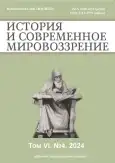Self-taxation of the Ural peasants in the 1920–1930s
- Authors: Filatov V.V.1
-
Affiliations:
- Nosov Magnitogorsk state technical University
- Issue: Vol 6, No 4 (2024)
- Pages: 29-42
- Section: HISTORY OF RUSSIA
- URL: https://journals.eco-vector.com/2658-4654/article/view/650773
- DOI: https://doi.org/10.33693/2658-4654-2024-6-4-29-42
- EDN: https://elibrary.ru/SKJURI
- ID: 650773
Cite item
Abstract
In the history of the Soviet state, the phenomenon of self-taxation of the rural population is of particular scientific interest. When studying the tax policy of our country in the 1920s and 1930s, one cannot ignore additional payments by the population along with the agricultural tax. Self-taxation had various forms: monetary, in-kind, and labor participation. Although the chosen topic has been studied by historians, it has not lost its relevance, since it can be studied from the point of view of domestic history, economic history, and the history of the state and law. Finding itself in the most difficult economic conditions, the country's leadership during the years of the new economic policy decided to use the initiative of the peasantry to improve life in the countryside, their cultural and economic needs with the help of voluntary self-taxation at first. After the grain procurement crisis of 1927/28, self-taxation changed from independent management of peasants’ funds to a mandatory element of the rural economy, when the forced confiscation of peasant funds served as an instrument for encouraging villagers to sell grain and other products on unfavorable terms. The purpose of the study is to reveal the features of the transformation of self-taxation from voluntary to compulsory using the example of the Urals, the largest region of the country. The object of study was the Ural peasantry. The subject of the study is the influence of the authorities, through legislation, on the independent, feasible participation of peasants in the development of rural infrastructure; the transformation of self-taxation into a mandatory payment; and the reflection of villagers on innovations in tax policy. The scientific novelty of the article lies in the comprehensive and systematic analysis of self-taxation in the Ural region based on numerous historical and legal sources, usually introduced into scientific circulation for the first time. The results of the conducted research showed that the authorities violated the initially defined rights of peasants to free expression of will in solving pressing cultural and social issues. Self-taxation became a mandatory, compulsory part of replenishing the rural budget.
Keywords
Full Text
About the authors
Vladimir V. Filatov
Nosov Magnitogorsk state technical University
Author for correspondence.
Email: v.philatov@mail.ru
ORCID iD: 0000-0003-3076-2324
Dr. Sci. (Hist.), Associate Professor, Leading Researcher at the Research Institute of Historical Anthropology and Philology
Russian Federation, MagnitogorskReferences
- Berkutov A.A. Self-taxation in direct tax payments of the peasantry in the second half of the 1920s // Historical, p hilosophical, political sciences, cultural studies and art criticism. Questions of theory and practice. Tambov: Gramota, 2013. No. 5 (31): in 2 parts. Part I. P. 22–25.
- Davletshin R.A. «The Great Turning Point» and the tragedy of the peasantry of Bashkortostan. Ufa: Kitap, 1993. P. 11.
- Ivnitsky N.A. Collectivization and dispossession (early 1930s). Moscow: Interpraks, 1994. 267 p.
- Ilyinykh V. A. Taxation of the Siberian Village: The End of the 1920s — the Beginning of the 1950s. Novosibirsk: GUP RPO SO RAAS, 2004. 167 p.
- Labuzov V. A. Agrarian Relations in the Southern Urals in the First Decades of Soviet Power (1917–1932). Orenburg: «ORLIT-A», 2004. 438 p.
- Motrevich V. P. Contribution to Victory: Agriculture of the Urals During the Great Patriotic War: Monograph. Yekaterinburg: OOO Universal Printing House «Alfa Print», 2021. 700 p.
- Okolotin V. S. The practice of self-taxation of the rural population in 1927-1928 (based on materials from the Vladimir, Ivanovo-Voznesensk, Kostroma and Yaroslavl provinces) // Bulletin of KSU named after N. A. Nekrasov. 2014. No. 5. P. 80–84.
- Okuda H. Self-taxation of the rural population in 1928-1933: on the issue of the last stage of the Russian peasant community // The 20th century and rural Russia. Russian and Japanese researchers in the project «History of the Russian peasantry in the 20th century». Tokyo: CIRJE Resarch Report CIRJE-R-2, 2005. P. 153–191.
- Filatov V. V. Taxation of Ural individual farmers with agricultural tax at the final stage of collectivization // History and modern worldview. 2023. Vol. 5. No. 4. P. 52–64.
- Filatov V. V. Preferences in the implementation of agricultural tax in the Urals in the early 1930s // History and modern worldview. 2023. Vol. 5. No. 1. P. 34–47.
- Filatov V. V. Agricultural tax in the Urals on the eve of mass collectivization // Questions of History. 2017. No. 6. P. 53–69.
- Filatov V. V. Implementation of agricultural tax among collective farmers of the Urals in the second half of the 1930s // History and modern worldview. 2024. Vol. 6. No. 1. P. 57–69.
- Filatov V. V. Ural village, 1927–1941: state of crime: Monograph. Magnitogorsk: State Educational Institution of Higher Professional Education «MGTU», 2009. 438 p.
- Filatov V. V. Ural village, 1927–1941: financing: monograph. Magnitogorsk: Publishing house of Magnitogorsk state tech. university named after G. I. Nosov, 2013. 238 p.
- Yashchuk T. F. Self-taxation of the population: from the experience of organizing local finances during the NEP period // Bulletin of Omsk University. Series «Law». 2007. No. 2 (11). P. 21–26.
Supplementary files








